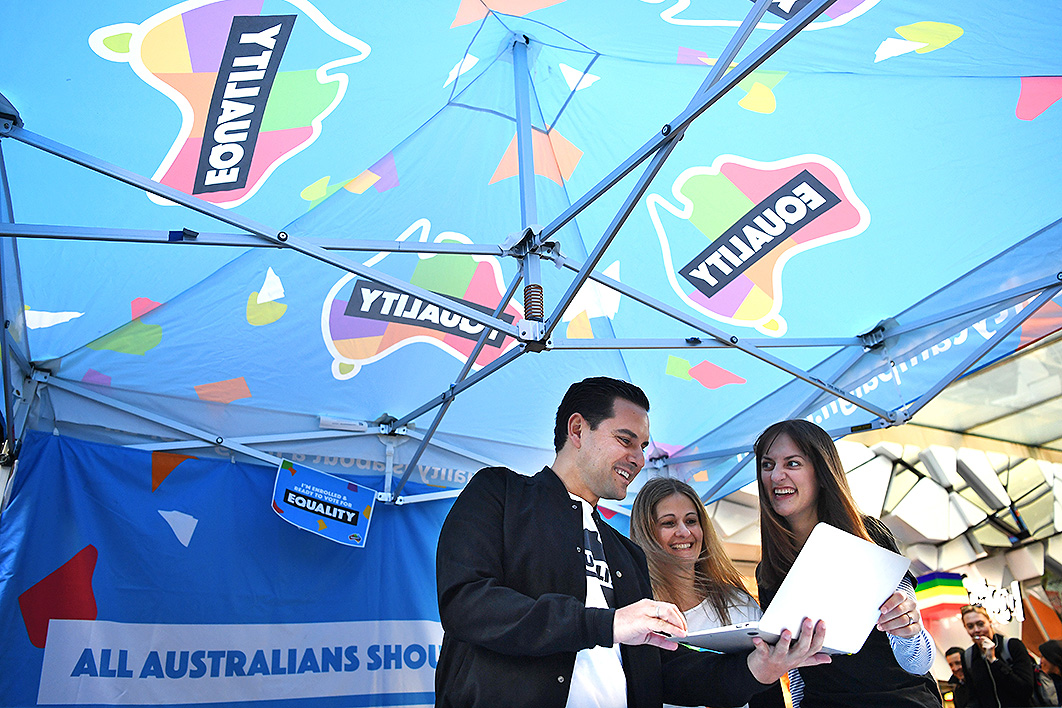Between last week and this week, a sub-narrative of the Great Australian Marriage Equality Survey Saga, the rate of enrolment among young Australians, turned on its head.
After the Australian Electoral Commission reported a big uptick in citizen-initiated enrolment activity, the very holding of a same-sex marriage survey was being roundly cast as an own goal for the Coalition government. It had unwittingly encouraged “hundreds of thousands” (according to one commentator) of youngsters — who overwhelmingly vote left-of-centre — to get on the roll, where they would remain for the next general election and beyond.
But that was then. In recent days, that line of argument has been replaced by fear and hand-wringing among Yes advocates who worry that, on the contrary, not enough youngsters are opting to participate. The most recent advice from the AEC has been a tweet announcing that the roll “increased by 54,545 between 8 & 22 August.” Of course, the list grows most months, and by widely varying amounts — in the year since the last election it averaged around 18,000 per month. So there has been a flurry of activity, but whether it’s substantial or not is in the eye of the beholder. (The AEC has not provided any breakdowns by age.)
A lot of big numbers are being thrown around, but percentages matter. As of 30 June this year (when the AEC released its latest age breakdown) an estimated 85.4 per cent of eligible eighteen- to twenty-four-year-olds were enrolled, compared with an overall figure of 95.1 per cent. That’s a gaping discrepancy, but still a big improvement on a few years ago. In 2011, the estimated completeness for that age group was 76 per cent, against a national number of 90 per cent.
That improvement has mostly been due to the introduction of direct enrolment, which allowed the AEC to update people’s details or put them on the roll using data from other government agencies. Unenrolled young people, not surprisingly, were overrepresented among the low-hanging fruit. Still, on 30 June this year, eighteen- to twenty-four-year-olds accounted for 10.3 per cent of the roll, 11.5 per cent of eligible voters — and 34.4 per cent of the estimated 800,000-odd who were missing.
You may or may not view these figures as stark. Five years ago the AEC was publicising the “missing 1.5 million,” and that’s been almost halved. But as last year’s election showed, being registered is one thing and turning out to vote is another — especially if new enrollees remain unaware of their entitlement.
This brings us to another popular meme prompted by the survey. For years, opinion polls have shown big majorities — around two to one — in favour of same-sex marriage. This doesn’t mean, of course, that this voluntary Australian Bureau of Statistics survey will record a Yes majority. For some commentators, the result will come down to turnout.
For example, in the Guardian Australia, Essential Media boss Peter Lewis quotes his own survey figures of 57 per cent in favour and 32 per cent against, and writes, “If everyone voted, there would clearly be a majority [in favour], but the optional vote means this postal survey is not an exercise in persuasion, rather one of mobilisation.”
I would flip this formulation around. It’s impossible to imagine uneven turnout undoing a 25 per cent lead. Trump, Brexit and this year’s British election produced turnout-induced shocks, but they were in the order of a few per cent. Characterising churches and other No groups as possessing a much greater capacity to enthuse and mobilise than marriage supporters seems a rather old-fashioned, and perhaps Americanised, view of Australian society.
The survey could certainly record a No majority, but not because it’s voluntary. What’s most important is that we are still ten long weeks away from the cut-off for returning the form. So far, the polls I’ve seen have asked people whether they support same-sex marriage, not how they’ll fill it in. For a big portion of the Australian electorate, constitutional referendums end up being about something other than the question in front of them — an opportunity to deliver a poke in the eye to the government of the day, for instance, or “elites.”
If the No side prevails, it will certainly be due to “persuasion.” Millions will need to decide that they’re not in favour of gay marriage after all, or at least not “this model,” or that there are too many unanswered questions, or that they don’t like what they might see as obnoxious Yes advocates. Surveys show females much more in favour of marriage equality than males, so any collapse in support would show up among women.
But, as I recently wrote, optionality assists the Yes case. Compulsory voting would have meant hordes of uninterested or softly committed voters dragged, grumpily, to the ballot box.
An analysis like this is sometimes met with arguments along the lines of “Why then would opponents of gay marriage like Peter Dutton have arranged this process if it didn’t advantage them?” This seems to attribute supreme tactical nous to an outfit that doesn’t generally attract rave political reviews.
Our immigration minister is not all-knowing, and neither are Eric Abetz and Kevin Andrews. They may well believe this procedure favours their desired outcome, but they’re not necessarily right. In fact, they’re wrong. •





